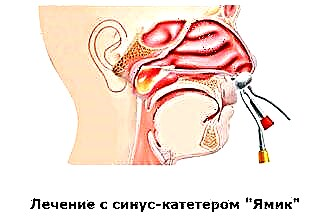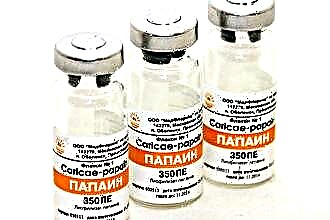Tracheal intubation - ensuring normal airway patency by introducing a special tube into the trachea. It is used to ventilate the lungs during resuscitation procedures, endotracheal anesthesia or airway obstruction. In otolaryngology, there are many supraglottic devices, but only intubation was and remains the only reliable way to ensure airway patency.
 Orotracheal intubation is one of the most common medical procedures.
Orotracheal intubation is one of the most common medical procedures.
During the procedure, an endotracheal tube (ETT) is passed through the entire oropharynx between the vocal cords directly into the trachea.
At the next stage, the cuff, which is located in the region of the distal tip of the tube, multiplies in volume, which ensures tightness and protection of the airways from the aspiration of bloody secretions and gastric juice.
Indications and contraindications
The technique of ventilation of the airways should be mastered by almost all medical personnel. In the presence of vital indications, medical manipulations should be performed by medical teams at the pre-hospital stage. Intubation in resuscitation conditions often takes on a planned nature and is carried out for prophylactic purposes with the help of muscle relaxants and induction of anesthesia.
Conventionally, all contraindications and indications for artificial ventilation of the lungs can be divided into absolute and relative.
Indications for medical manipulation include:
1. Absolute:
- aspiration syndrome;
- obstruction of the airways;
- traumatic brain injury;
- pulmonary cardiac resuscitation (LSR);
- deep coma of various origins.
2. Relative:
- eclampsia;
- thermal inhalation trauma;
- pulmonary edema;
- shock of various origins;
- strangulation asphyxia;
- pneumonia;
- pulmonary insufficiency;
- status epilepticus.
In the presence of relative indications for the procedure, the decision on artificial ventilation of the airways is made individually and depends on the cause of the patient's emergency.
It is impossible to intubate patients in prehospital conditions if there are direct contraindications.
This can cause serious complications, including hypercapnia, bronchospasm, hypoxia, etc. Artificial ventilation of the lungs by means of ETT is contraindicated in case of oncology of the airways, deformation of the skull, damage to the spine, severe edema of the larynx and pharynx, ankylosis of the temporomandibular joints and contractures.
Intubation instrumentation
How is tracheal intubation performed? The technique of carrying out medical manipulations is described in detail in the next section and consists in the competent introduction of the necessary instrumentation into the upper respiratory tract. The equipment through which patients are intubated should consist of:
- laryngoscope - a medical instrument that is used to facilitate visualization of the larynx; Laryngoscopes with curved tips, which provide a wide view of the airway, are considered the least traumatic;
- trocar - a surgical instrument used to penetrate human cavities; a standard device consists of a special stylet (guide) equipped with a handle;
- surgical clamp - metal scissors with blunt blades, which are used to cleanse the oral cavity from viscous secretions;
- ventilation bag - a rubber bulb that connects to ETT for manual ventilation of the lungs;
- endotracheal tubes - thin tubular devices that are made from thermoplastic materials; after insertion, the tube in the trachea increases in size at the level of the cuff, which ensures obturation of the lumen between the medical equipment and the walls of the airways;
- instruments for sanitation - an aspirator and a special catheter designed to cleanse the trachea from liquid secretions, blood and gastric juice.
 All patients admitted to the ambulance can be classified as having a full stomach, which obliges the medical staff to carry out full induction with the use of Sellick (a method of pressing on the cricoid cartilage), which prevents the aspiration of mucus and gastric juice.
All patients admitted to the ambulance can be classified as having a full stomach, which obliges the medical staff to carry out full induction with the use of Sellick (a method of pressing on the cricoid cartilage), which prevents the aspiration of mucus and gastric juice.
Muscle relaxation and general anesthesia are necessary conditions for performing the necessary medical procedures.
When the body is completely relaxed, the risk of damage to the mucous membrane of the airways is greatly reduced.
However, it is almost impossible to achieve optimal conditions in a prehospital setting.
Intubation technique
In most cases, intubation is performed through the mouth, which is due to the ability to control the actions performed using direct laryngoscopy. During therapy, the patient's position should be extremely horizontal. The maximum possible alignment of the neck is achieved by a small cushion placed under the cervical spine articulation.
What is the technique for tracheal intubation?
- by means of special preparations (relaxants, barbiturates), the patient is put into anesthesia;
- for 2-3 minutes, the specialist conducts artificial ventilation of the respiratory tract using an oxygen mask;
- the resuscitator opens the patient's mouth with his right hand, and then inserts a laryngoscope into the oral cavity;
- the blade of the tool is pressed against the root of the tongue, which allows the epiglottis to be pushed up;
- after exposing the entrance to the pharynx, the doctor inserts an endotracheal tube.
Inappropriate intruder manipulation can lead to hypoxia or collapse of one of the patient's lungs.
To resume ventilation of the non-breathing lung, the specialist pulls the tube back a little. The complete absence of whistling sounds in the lungs may signal the penetration of ETT into the stomach. In such a situation, the doctor removes the tube from the oropharynx and resuscitates the patient by hyperventilating the lungs with 100% oxygen.
Intubation of newborns
 Tracheal intubation in newborns is one of the most common medical procedures used for meconium aspiration, abdominal wall abnormalities or diaphragmatic hernia. Often, artificial ventilation in children is necessary to create a peak inspiratory pressure, which allows the normal functioning of the lungs.
Tracheal intubation in newborns is one of the most common medical procedures used for meconium aspiration, abdominal wall abnormalities or diaphragmatic hernia. Often, artificial ventilation in children is necessary to create a peak inspiratory pressure, which allows the normal functioning of the lungs.
How is neonatal intubation performed? To reduce the likelihood of complications, ETT is administered through the nasopharynx. During the procedure, the specialist performs the following actions:
- ventilates the lungs with an oxygen mask until satisfactory saturation is achieved;
- with the help of an aspirator and a thin tube, the bronchi and respiratory tract are completely cleared of mucus, meconium and foamy secretions;
- to visualize the entrance to the pharynx, the specialist presses the larynx with his little finger from the outside; the tip of the ETT is lubricated with xylocaine cream, after which it is carefully inserted through the nasal canal into the trachea;
- during auscultation of respiration, the resuscitator determines the intensity of the noise in each of the lungs; at the final stage, an artificial respiration apparatus is connected to the ETT through special adapters.
Important! If a child is connected to a ventilator for a long time, it can lead to the development of bradycardia (slow heart rate).
Intubated children are observed for several days in the intensive care unit.In the absence of complications and restoration of respiratory function, the intubation instrumentation is carefully removed.
Difficult intubation
"Difficult intubation" is a situation characterized by repeated attempts to correctly position the ETT in the trachea. Medical manipulations at the prehospital stage are associated with poor conditions for resuscitation procedures. Untimely provision of medical care can cause asphyxiation and even death.
Intubation outside the operating room is usually used in extreme cases, i.e. in the presence of vital indications.
 The category of patients with very high risks of tubal intubation include:
The category of patients with very high risks of tubal intubation include:
- women during gestation;
- persons with serious cranial and jaw injuries;
- overweight patients (grade 3-4 obesity);
- patients with diabetes mellitus;
- persons with thermal inhalation injuries.
In all of the above cases, the use of intubation becomes much more complicated. To assess the patient's condition, the doctor performs ventilation of the lungs using an oxygen mask.
If oxygenation (oxygen treatment) does not give the desired results, the resuscitator should ventilate with ETT. Obstruction of the airways can lead to hypoxia, therefore, in the most extreme case, the doctor performs a conicotomy, i.e. dissection of the larynx.
Possible complications
Complications after the resuscitation procedure arise mainly as a result of incorrect insertion and fixation of ETT. Some anatomical features of a patient, such as obesity or limited mobility of the spine, greatly increase the risk of complications. Common consequences of intubation include:
- stopping blood circulation;
- aspiration of gastric juice;
- decay of teeth or dentures;
- intubation of the digestive tract;
- atelectasis (collapse of the lung);
- perforation of the oropharyngeal mucosa;
- damage to the ligaments of the throat.
In most cases, complications arise due to the incompetence of a specialist and the lack of control of the measured characteristics using the appropriate equipment. It is important to understand that improper placement of the endotracheal tube leads to tracheal rupture and death.
Important nuances
 Timely determination of the correct installation of the endotracheal tube is an important technical nuance that must be taken into account by a specialist. If the ETT cuff is not inserted deeply enough, its expansion can rupture the vocal cords and damage the trachea. To check the correct installation of the intubation equipment, carry out:
Timely determination of the correct installation of the endotracheal tube is an important technical nuance that must be taken into account by a specialist. If the ETT cuff is not inserted deeply enough, its expansion can rupture the vocal cords and damage the trachea. To check the correct installation of the intubation equipment, carry out:
- hemoximetry - a non-invasive method for determining the level of blood oxygen saturation;
- capnometry - a numerical display of the partial pressure of CO2 in the inhaled and exhaled air;
- auscultation - a physical diagnosis of the patient's condition by the sounds generated in the lungs during the functioning of the lungs.
An intubation tube is inserted into the trachea not only in the presence of vital indications, but also during anesthesia. General anesthesia, which is accompanied by a shutdown of the patient's consciousness, can cause respiratory failure or airway obstruction. To reduce the risks of aspiration of gastric juice and foamy secretions, ETT or a laryngeal mask are often used during surgical procedures.

 In the presence of relative indications for the procedure, the decision on artificial ventilation of the airways is made individually and depends on the cause of the patient's emergency.
In the presence of relative indications for the procedure, the decision on artificial ventilation of the airways is made individually and depends on the cause of the patient's emergency.

